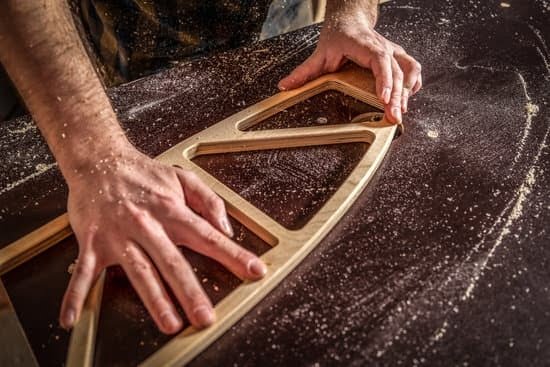What do joints have in common with woodwork? Joints play a crucial role in woodworking, as they are essential for creating sturdy and durable woodwork pieces.
Whether it’s furniture, structures, or decorative pieces, the quality of the joints determines the overall strength and longevity of the finished product. In this article, we will explore the different aspects of joints in woodworking, including their types, importance of precision, common materials used, techniques and tools, historical significance, challenges in joint making, and examples of impressive joints.
When it comes to woodworking, understanding the various types of joints is essential for creating well-crafted pieces. From butt joints to lap joints and dovetail joints, each type has its unique characteristics and uses. Additionally, precision and accuracy play a significant role in creating strong and durable joints. The materials used in creating these joints, such as wood glue, screws, and dowels also contribute to their strength and durability.
Throughout history, joints have been utilized in woodworking to create impressive woodwork pieces that stand the test of time. However, creating perfect joints comes with its own set of challenges and difficulties. By exploring the techniques and tools used in creating joints and showcasing examples of exceptional joint work in woodwork pieces, we can gain a deeper understanding of the importance of paying attention to detail when it comes to creating high-quality and long-lasting woodwork pieces.
Types of Joints
Butt Joints
One of the most basic and commonly used joints in woodworking is the butt joint. This type of joint involves joining two pieces of wood by simply butting them together. While butt joints are easy to create, they are not necessarily the strongest option, especially when used on their own. However, they can be reinforced with additional fasteners or adhesives to improve their strength and durability.
Lap Joints
Lap joints are created by overlapping two pieces of wood and then fastening them together. This type of joint is known for its versatility and ability to withstand weight and stress. Lap joints come in various forms, including half-lap, cross-lap, and dovetail lap joints, each serving different purposes based on the specific woodworking project.
Dovetail Joints
Dovetail joints are revered for their unparalleled strength and aesthetic appeal. These interlocking joints are often used in high-quality furniture making due to their reliability and resistance to being pulled apart. The unique wedge-shaped design of dovetail joints provides a secure connection that adds both visual interest and structural integrity to woodwork pieces.
When it comes to what do joints have in common woodwork, all three types mentioned above share the characteristic of providing essential support and stability to woodworking projects. Regardless of the specific type of joint used, careful consideration must be given to its design and execution to ensure that it serves its intended purpose effectively.
Furthermore, understanding the unique characteristics and uses of different types of joints allows woodworkers to make informed decisions when selecting the most suitable joint for a particular project.
Importance of Precision
Precision and accuracy are crucial elements in creating joints in woodworking. The fit of a joint can determine the strength, durability, and overall quality of the woodwork piece. Without precision, joints may not hold together properly, leading to instability and potential structural issues. This is why woodworkers must pay careful attention to achieving accurate measurements and cuts when creating joints.
To emphasize the importance of precision, it’s essential to consider the different types of joints commonly used in woodworking. Whether it’s a simple butt joint or a complex dovetail joint, each type requires precise measurements and cuts to ensure a proper fit. For example:
- Butt Joints: Requires accurate cutting and alignment to create a flush connection between two pieces of wood.
- Lap Joints: Precision is necessary for properly overlapping the wood pieces to strengthen the joint.
- Dovetail Joints: The unique interlocking design of dovetail joints demands meticulous cutting to form tight-fitting connections.
When discussing precision in woodworking joints, it’s important to also consider the tools and techniques used in creating them. Woodworkers often rely on chisels, saws, router tables, and other specialized tools to achieve the level of accuracy required for various joint types. Additionally, employing proper measurement techniques and attention to detail is crucial for ensuring that each joint is crafted with precision.
Additionally, precision plays a significant role in contributing to the longevity of woodwork pieces. Well-crafted joints that are accurately measured and cut are more likely to withstand wear and tear over time, ultimately prolonging the life of furniture or structures. When joints are made with precision, they provide sturdy connections that can endure constant use without compromising their integrity.
What do joints have in common woodwork? They all require precision and accuracy to ensure their strength, functionality, and longevity. By understanding the significance of precision in creating joints, woodworkers can uphold high standards of craftsmanship and produce exceptional woodwork pieces that stand the test of time.
Common Materials Used
When it comes to creating sturdy and durable joints in woodworking, the materials used play a critical role in ensuring the strength and longevity of the finished piece. Here are some common materials used in creating joints and how they contribute to the overall quality of the woodwork:
- Wood Glue: One of the most commonly used materials for creating joints in woodworking is wood glue. This adhesive is essential for bonding two pieces of wood together, creating a strong and seamless joint. When applied properly, wood glue forms a tight bond that adds to the overall strength of the joint, making it an indispensable material in woodworking.
- Screws: Screws are another popular choice for creating joints, especially in projects where disassembly may be necessary. When used in conjunction with other techniques such as dowels or biscuits, screws can provide added reinforcement to the joint, increasing its stability and durability.
- Dowels: Wooden dowels are often used to reinforce joints and add extra strength to woodworking projects. By drilling corresponding holes into adjoining pieces and inserting dowels coated with glue, woodworkers can create incredibly strong joints that are less likely to shift or loosen over time.
These materials not only contribute to the physical strength of the joint but also aid in enhancing its overall durability. By understanding how each material functions within a joint and employing precise techniques during assembly, woodworkers can ensure that their creations will stand the test of time.
Techniques and Tools
Chisels
Chisels are essential tools for creating intricate joints in woodworking. They are used to remove wood and shape the joint with precision. The sharp edge of a chisel allows woodworkers to carefully carve out the necessary material to achieve a tight and secure fit for the joint. Chisels come in various sizes and shapes, allowing for versatility in joint design.
Saws
Saws are another crucial tool in creating joints in woodworking. Different types of saws, such as hand saws and power saws, are used to cut wood at precise angles and dimensions to create the necessary components for joining pieces together. For example, a miter saw is commonly used to create angled cuts for miter joints, while a dovetail saw is designed specifically for creating dovetail joints.
Router Tables
Router tables play a vital role in achieving well-crafted joints by allowing woodworkers to create intricately shaped edges and grooves in wood pieces. Router bits can be used to create dado joints, rabbet joints, and tongue-and-groove joints with precision. The versatility of router tables makes them an essential tool for achieving complex joint designs in woodworking.
Historical Significance
Woodworking joints have a rich and significant history that dates back centuries, playing a crucial role in the creation of various impressive woodwork pieces. From ancient civilizations to modern woodworking practices, joints have been utilized to construct furniture, structures, and decorative pieces. The historical significance of joints in woodworking is evident in the intricate and durable woodwork pieces that have stood the test of time.
Historically, different cultures have developed their distinct styles and techniques for creating joints in woodworking. For example, ancient Egyptian artisans used complex interlocking joints to build furniture such as beds and chairs, showcasing their advanced skills in joinery. Similarly, Japanese woodworking traditions feature intricate joinery techniques that result in sturdy and visually stunning woodwork pieces. The historical significance of these traditional joint-making methods continues to influence modern woodworking practices.
Furthermore, throughout history, joints have played a vital role in architectural construction, with craftsmen using precise joinery techniques to create strong and resilient structures. The longevity of historical buildings and structures is a testament to the importance of well-crafted joints in woodworking. As advancements in technology and tools continue to evolve, preserving and learning from traditional joinery techniques remains essential for understanding the historical significance of joints in woodworking.
| Historical Era | Joint-Making Techniques |
|---|---|
| Ancient Egypt | Complex interlocking joints for furniture construction |
| Japanese Woodworking | Intricate joinery techniques for sturdy woodwork pieces |
| Medieval Europe | Pegged mortise-and-tenon joints for architectural construction |
Challenges in Joint Making
Creating strong and durable joints in woodworking is essential for ensuring the longevity and structural integrity of woodwork pieces. However, achieving the perfect fit and ensuring that the joints are sturdy and secure can present several challenges and difficulties for woodworkers.
One of the primary challenges in joint making is achieving a perfect fit between the mating surfaces of the wood pieces. This requires precise measurements, careful cutting, and meticulous attention to detail. Even a small deviation from the intended dimensions can result in a loose or uneven joint, compromising its strength and stability.
Another common challenge is ensuring that the joints are sturdy and secure enough to withstand the stresses and strains placed on them. This involves selecting the appropriate type of joint for the specific application, as well as using suitable materials and techniques to enhance the joint’s strength. Woodworkers must consider factors such as weight-bearing capabilities, lateral forces, and environmental conditions when determining the best approach to creating strong and secure joints.
In addition to achieving a perfect fit and ensuring sturdiness, woodworkers also face challenges related to concealing or minimizing visible joints in finished woodwork pieces. While some projects may benefit aesthetically from exposed joints, others require a seamless appearance that disguises any signs of joinery. This demand for “invisible” joints adds another layer of complexity to joint making in woodworking, requiring advanced skills and techniques to achieve flawless results.
Overall, overcoming these challenges in joint making requires patience, skill, precision, and experience. By understanding these common difficulties and implementing strategies to address them effectively, woodworkers can ensure that their joints are not only functional but also contribute to the overall beauty and quality of their woodwork projects.
Examples of Impressive Joints
When it comes to woodworking, joints play a crucial role in creating sturdy and durable woodwork pieces. But what do joints have in common with woodwork? The answer lies in the precision and craftsmanship required to create seamless connections that enhance the overall beauty and functionality of furniture or structures. Let’s explore some examples of impressive joints that highlight exceptional woodwork pieces and how they contribute to the quality of the final product.
One notable example of impressive joint work can be seen in the construction of traditional Japanese timber framing. This ancient technique involves intricate joinery that does not rely on nails or hardware, but rather on precise cuts and interlocking connections. The result is beautiful, strong, and resilient wooden structures that have withstood the test of time for centuries.
Another remarkable example is found in antique furniture, particularly pieces crafted during the Victorian era. These pieces often feature ornate and complex joinery such as dovetail joints, mortise and tenon joints, and tongue and groove joints. The attention to detail and craftsmanship in these joints not only adds aesthetic value to the furniture but also ensures its longevity and durability.
In modern woodworking, contemporary designers and craftsmen continue to push the boundaries of joint work, using innovative techniques to create visually striking and structurally sound woodwork pieces. From intricately carved joinery in custom-made cabinetry to seamless connections in designer tables and chairs, these examples showcase how exceptional joint work can elevate both the beauty and functionality of woodwork.
| Impressive Joint Example | Description |
|---|---|
| Traditional Japanese Timber Framing | Intricate joinery without relying on nails or hardware |
| Victorian Era Antique Furniture | Ornate and complex joinery for aesthetic value as well as longevity |
| Contemporary Woodwork Pieces | Innovative techniques for visually striking yet structurally sound results |
These examples serve as a testament to the significance of paying attention to joint work in woodworking, showcasing how it contributes not only to the strength but also to the overall beauty of woodwork pieces. By highlighting exceptional joint work, these examples inspire craftsmen and designers alike to continue pushing the boundaries of what is possible with woodworking techniques.
Conclusion
In conclusion, it is evident that joints play a crucial role in woodworking, serving as the foundation for creating sturdy and durable woodwork pieces. Whether it’s butt joints, lap joints, or dovetail joints, each type has its unique characteristics and uses, highlighting the importance of precision and accuracy in their creation.
The materials used, such as wood glue, screws, and dowels, contribute to the strength and durability of the joints, while techniques and tools like chisels, saws, and router tables are essential for achieving well-crafted joints.
Throughout history, joints have been utilized to create impressive woodwork pieces, showcasing exceptional craftsmanship and enhancing the overall beauty and functionality of furniture or structures. However, creating quality joints does come with its challenges; achieving a perfect fit and ensuring the joints are secure are common difficulties that woodworkers face. Despite these challenges, attention to detail in joint making is vital for producing high-quality and long-lasting woodwork pieces.
It is clear that paying attention to the details of joints in woodworking is essential for achieving excellence in craftmanship. By understanding the various types of joints available and employing precision in their creation with the right materials and tools, woodworkers can produce impressive woodwork pieces that stand the test of time. Ultimately, an appreciation for joint work allows woodworkers to elevate their craft and create enduring works of art for generations to come.
Frequently Asked Questions
What Are Joints Used for in Woodwork?
Joints in woodworking are used to connect two pieces of wood together. They provide strength, stability, and flexibility to the overall structure of the woodwork. Different types of joints are used for different purposes, such as joining corners or attaching tabletops.
What Is the Most Common Joint in Woodworking?
The most common joint in woodworking is the butt joint. It’s simple and quick to create, but it’s not the strongest option. Other popular joints include the dovetail joint, mortise and tenon joint, and finger joint, each with its own strengths and weaknesses.
How Do Joints Affect the Quality of a Woodwork?
Joints play a crucial role in determining the quality of a woodwork project. A well-constructed joint ensures that the piece is strong and durable, while a poorly made joint can compromise the entire structure. Properly fitting joints also contribute to the aesthetics of the finished piece, creating a seamless and professional appearance.

Hi everyone! I’m a woodworker and blogger, and this is my woodworking blog. In my blog, I share tips and tricks for woodworkers of all skill levels, as well as project ideas that you can try yourself.





